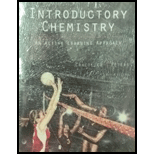
Concept explainers
Interpretation:
The amount of energy gained by the sample when the temperature is changed from
Concept introduction:
The amount of energy required to change the state of a substance is known as enthalpy. It is the difference in the energy of the final and initial state of a substance. The negative and positive sign of enthalpy indicates the energy released and energy absorbed, respectively, during the phase change.
Answer to Problem 93E
The amount of energy gained by the sample when the temperature is changed from
Explanation of Solution
Three stages are involved when the temperature of ice sample is raised from
The amount of energy required to raise the temperature of ice from
Where,
•
•
•
•
The specific heat of ice is
Substitute the mass, final, initial temperature and specific heat of ice in equation (1).
The amount of energy required to melt a solid is calculated by the formula shown below.
Where,
•
The heat of fusion of water is
Substitute the mass and heat of fusion in equation (2).
The amount of energy required to raise the temperature of water from
Where,
•
•
•
•
The specific heat of water is
Substitute the mass, final, initial temperature and specific heat of water in equation (3).
The total amount of energy sample gained when temperature is changed from
Convert
The amount of energy sample gained when temperature is changed from
Want to see more full solutions like this?
Chapter 15 Solutions
Bundle: Introductory Chemistry: An Active Learning Approach, 6th + LMS Integrated for OWLv2, 4 terms (24 months) Printed Access Card
- If you want to convert 56.0 g ice (at 0 °C) to water at 75.0 °C, calculate how many grams of propane, C3H8, you would have to bum to supply the energy to melt the ice and then warm it to the final temperature (at 1 bar).arrow_forward9.46 The heat of fusion of pure silicon is 43.4 kJ/mol. How much energy would be needed to melt a 5.24-g sample of silicon at its melting point of 1693 K?arrow_forwardThe enthalpy change when 1 mol methane (CH4) is burned is 890 kJ. It takes 44.0 kJ to vaporize 1 mol water. What mass of methane must be burned to provide the heat needed to vaporize 1.00 g water?arrow_forward
- Define the joule in terms of SI base units.arrow_forwardSuppose you wanted to cool 100. g of water from 20 C to 0 C using dry ice, CO2(s). The enthalpy of sublimation of CO2(s) is 25.2 kJ/mol. What mass of dry ice should you need? (a) 033 g (b) 15 g (c) 3.5 g (d) 150 garrow_forwardThe amount of heat required to melt 2 lbs of ice is twice the amount of heat required to melt 1 lb of ice. Is this observation a macroscopic or microscopic description of chemical behavior? Explain your answer.arrow_forward
- The cooling effect of alcohol on the skin is due to its evaporation. Calculate the heat of vaporization of ethanol (ethyl alcohol), C2H5OH. C2H5OH(l)C2H5OH(g);H=? The standard enthalpy of formation of C2H5OH(l) is 277.7 kJ/mol and that of C2H5OH(g) is 235.1 kJ/mol.arrow_forwardSublimation is the phase change from solid to gas without going through a liquid phase. Solid CO2, called dry ice, is an example of one substance that sublimed. Use Hesss law to show that the enthalpy of sublimation, subH, is equal to fusH vapH.arrow_forwardHow much heat, in joules and in calories, is required to heat a 28.4-g (1-oz) ice cube from 23.0 C to 1.0 C?arrow_forward
- You heat 1.000 quart of water from 25.0C to its normal boiling point by burning a quantity of methane gas, CH4. What volume of methane at 23.0C and 745 mmHg would you require to heat this quantity of water, assuming that the methane is completely burned? The products are liquid water and gaseous carbon dioxide.arrow_forwardBenzene, C6H6, is an organic liquid that freezes at 5.5 C (Figure 11.1) to form beautiful, feather-like crystals. How much energy is evolved as heat when 15.5 g of benzene freezes at 5.5 C? (The enthalpy of fusion of benzene is 9.95 kJ/mol.) If the 15.5-g sample is remelted, again at 5.5 C, what quantity of energy is required to convert it to a liquid?arrow_forwardEvaporation of sweat requires energy and thus take excess heat away from the body. Some of the water that you drink may eventually be converted into sweat and evaporate. If you drink a 20-ounce bottle of water that had been in the refrigerator at 3.8 C, how much heat is needed to convert all of that water into sweat and then to vapor? (Note: Your body temperature is 36.6 oc. For the purpose of solving this problem, assume that the thermal properties of sweat are the same as for water.)arrow_forward
 World of ChemistryChemistryISBN:9780618562763Author:Steven S. ZumdahlPublisher:Houghton Mifflin College Div
World of ChemistryChemistryISBN:9780618562763Author:Steven S. ZumdahlPublisher:Houghton Mifflin College Div Living By Chemistry: First Edition TextbookChemistryISBN:9781559539418Author:Angelica StacyPublisher:MAC HIGHER
Living By Chemistry: First Edition TextbookChemistryISBN:9781559539418Author:Angelica StacyPublisher:MAC HIGHER Chemistry & Chemical ReactivityChemistryISBN:9781133949640Author:John C. Kotz, Paul M. Treichel, John Townsend, David TreichelPublisher:Cengage Learning
Chemistry & Chemical ReactivityChemistryISBN:9781133949640Author:John C. Kotz, Paul M. Treichel, John Townsend, David TreichelPublisher:Cengage Learning Chemistry by OpenStax (2015-05-04)ChemistryISBN:9781938168390Author:Klaus Theopold, Richard H Langley, Paul Flowers, William R. Robinson, Mark BlaserPublisher:OpenStax
Chemistry by OpenStax (2015-05-04)ChemistryISBN:9781938168390Author:Klaus Theopold, Richard H Langley, Paul Flowers, William R. Robinson, Mark BlaserPublisher:OpenStax Chemistry: The Molecular ScienceChemistryISBN:9781285199047Author:John W. Moore, Conrad L. StanitskiPublisher:Cengage Learning
Chemistry: The Molecular ScienceChemistryISBN:9781285199047Author:John W. Moore, Conrad L. StanitskiPublisher:Cengage Learning Chemistry for Engineering StudentsChemistryISBN:9781337398909Author:Lawrence S. Brown, Tom HolmePublisher:Cengage Learning
Chemistry for Engineering StudentsChemistryISBN:9781337398909Author:Lawrence S. Brown, Tom HolmePublisher:Cengage Learning





